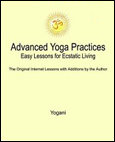|
Public Home | Plus Home | Main Lessons | Tantra Lessons | Public Forum | Plus Forum | Downloads | Books Topic Paths | Search | Training-Retreats | Testimonials | Survey | Interviews | MultiMedia | Contact | Donate |
|
Advanced Yoga Practices Note: For the Original Internet Lessons with additions, see the AYP Easy Lessons Books. For the Expanded and Interactive Internet Lessons, AYP Online Books, Audiobooks and more, see AYP Plus. Lesson 360 - Acts of Surrender (Audio)
From: Yogani New Visitors: It is recommended you read from the beginning of the archive, as previous lessons are prerequisite to this one. The first lesson is, "Why This Discussion?"
A: Surrender is not a passive act, nor a lack of acting at all. In fact, in the AYP writings, we often put the word "active" in front of it: "Active surrender." Real surrender requires an earnest effort. Paradoxical as it may seem, it is true. Many aspects of spiritual life involve paradox. It is up to us to walk on through. Then we see what it is for ourselves. If you have dissatisfaction with your present situation, you are a tiny step from good bhakti (spiritual desire), leading to a transformation of your life. Just act on your dissatisfaction in any way you feel can move you forward. There are a thousand ways to do that. Wallowing in regret is not one of them. If you make a habit of acting for your best interest, everything will change for the better. That is the result of surrender to and acting upon the call that comes to us in every aspect of our life. Just say "yes" and do it. Acting to transform perceived shortcomings in our situation is a systematic approach that utilizes our emotional energy. It does not matter whether the energy is positive or negative. Either one can be used with good results. Anger is as useful for bhakti as passion is. These energies can be used in ways that can greatly enhance our spiritual progress. See Lessons 67 and 340. Bhakti is the redirecting of our emotional energy toward a higher ideal of our own choosing. So, if we are languishing about the house, imagining that we have nothing to do, and have grown an emotion of self-absorbed dissatisfaction around that, we can use that energy simply by redirecting it toward getting out of the house. We can take the dullness that is occurring and do the reverse. We can sign up for a yoga class, or an exercise program. If we are not the type to join a group, we can help out a neighbor, get a pet to take care of, or cultivate a garden in the back yard. If we don't have others to take care of already, adding on some responsibilities like that can go a long way toward snapping us out of the doldrums. Are you taking care of something or someone besides yourself? If not, consider doing that. If nothing else appeals, then take a good long walk every day. Of course, committing ourselves to a daily routine of sitting spiritual practice such as deep meditation will give us extra energy and a growing ability to see our situation for what it is an inertia that has crept into our life, and which can be redirected simply by getting up and doing something else. If our malaise is psychologically chronic, or involves the consumption of alcohol or other debilitating substances, then we will be wise to act on our recognition of that by seeking professional help. In that case, those who care about us will have concern, and we should consider their advice. All conditions are stages on our path, and it is up to us to move to the next stage, whether we are receiving help or not. There is no getting around the responsibility we have for our own life. We can begin with small steps, and gradually increase them. Look at what is in front of you today. You have a choice. Will you stay on the couch, or will you get up and walk outside? It is up to you. Here are a few relevant lines from a famous Jelaluddin Rumi poem:
"Keep walking, though there is no place to
get to. So the suggestion is to keep walking in active surrender on the path of progress that lies before you in this very moment. You will find you have lots of inspiring company on your path, once you take a few steps on your own. Those first few steps might be a bit challenging, because you are establishing a new momentum in your life. After that, it becomes much easier. Try and see. All the best! The guru is in you. Discuss this Lesson in the AYP Plus Support Forum Note: For detailed discussion on the role of surrender on our path to enlightenment, see the Bhakti and Karma Yoga book, and AYP Plus. |
|
|
|
Join the Mail List:
AYP Retreats
eBooks - PDF, EPUB
FREE eBooks with
SAVE with Bundled
|

























